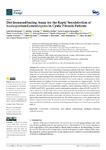2023-01-24Zeitschriftenartikel
Dot Immunobinding Assay for the Rapid Serodetection of Scedosporium/Lomentospora in Cystic Fibrosis Patients
Martin-Souto, Leire
Antoran, Aitziber
Areitio, Maialen
Aparicio-Fernandez, Leire
Martín-Gómez, María Teresa
Fernandez, Roberto
Astigarraga, Egoitz
Barreda-Gómez, Gabriel
Schwarz, Carsten
Rickerts, Volker
Hernando, Fernando L.
Rementeria, Aitor
Buldain, Idoia
Ramirez-Garcia, Andoni
The detection of Scedosporium/Lomentospora is still based on non-standardized low-sensitivity
culture procedures. This fact is particularly worrying in patients with cystic fibrosis (CF), where
these fungi are the second most common filamentous fungi isolated, because a poor and delayed
diagnosis can worsen the prognosis of the disease. To contribute to the discovery of new diagnostic
strategies, a rapid serological dot immunobinding assay (DIA) that allows the detection of serum
IgG against Scedosporium/Lomentospora in less than 15 min was developed. A crude protein extract
from the conidia and hyphae of Scedosporium boydii was employed as a fungal antigen. The DIA
was evaluated using 303 CF serum samples (162 patients) grouped according to the detection of
Scedosporium/Lomentospora in the respiratory sample by culture, obtaining a sensitivity and specificity
of 90.48% and 79.30%, respectively; positive and negative predictive values of 54.81% and 96.77%,
and an efficiency of 81.72%. The clinical factors associated with the results were also studied using
a univariate and a multivariate analysis, which showed that Scedosporium/Lomentospora positive
sputum, elevated anti-Aspergillus serum IgG and chronic Pseudomonas aeruginosa infection were
significantly associated with a positive result in DIA, while Staphylococcus aureus positive sputum
showed a negative association. In conclusion, the test developed can offer a complementary, rapid,
simple and sensitive method to contribute to the diagnosis of Scedosporium/Lomentospora in patients
with CF.

